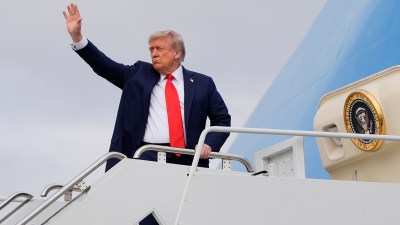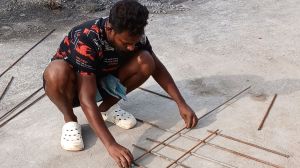When a ‘Packet’ with Dalai Lama onboard made an emergency landing in Leh
The C-119G Fairchild Packet aircraft was phased out in 1986 and replaced with the Russian workhorse AN-32.
 A Packet which force landed near Agra in a village called Sawai. The plane was repaired and flown away by preparing a ‘kutcha’ airstrip and promptly named ‘Sawai ki Rani’.
A Packet which force landed near Agra in a village called Sawai. The plane was repaired and flown away by preparing a ‘kutcha’ airstrip and promptly named ‘Sawai ki Rani’.It was on October 23, 1972, that Tibetan spiritual leader, the Dalai Lama, survived an engine fire scare in the legendary C-119G Fairchild Packet aircraft of the Indian Air Force (IAF) while flying from Punjab’s Pathankot to Thoise in Ladakh.
The story of this eventful flight was recounted by Wing Commander N J D Conceicao, the former CO of Paratrooper Training School, Agra, at the recently held reunion of the Packets family in that city.
“I received the Dalai Lama with the undersecretary of foreign affairs and invited him to the cockpit and took off for Thoise. At around 18,000 feet near Eagle’s Nest, I made a port turn and opened full power to climb to 20,000 feet. There was a loud explosion on the starboard engine and it caught fire,” recounted the Wing Commander, who was then a detachment commander of Packets in Pathankot.
 Packet Veterans and their wives at the Agra drop zone with members if the IAF sky diving team during their reunion celebrations.
Packet Veterans and their wives at the Agra drop zone with members if the IAF sky diving team during their reunion celebrations.
“An emergency shut down of the engine was executed and it was shut down and the flight was diverted to Leh after intimating the Dalai Lama, who started praying on his rosary beads and looking at the altimeter on his wrist. A safe landing was executed at Leh and the Dalai Lama was later taken to Thoise in another aircraft. After landing he thanked me profusely, bowing in front of me,” he recalled.
Reliving memories
These memories were among the many which were recounted by the family of ‘Packet aviators’, who flew the C-119 G Fairchild transport aircraft of the IAF, earlier this week to celebrate a reunion at the Agra air base.
Veterans and their lady wives, who spent the golden period of their lives in the company of Packet aircraft in Paratrooper Training School, Nos 12, 19, and 48 Squadrons, relived the memories of another day in each other’s company.
Among those who could make it to the occasion were Air Marshal A K Goel, Air Marshal K N Nair, Air Vice Marshal Kapil Kak, Air Vice Marshal H P Singh, Group Captain R S Cheema, Group Captain V K Khandelwal and many more, 123 officers and spouses to be exact.
The senior-most officer in terms of service was Wing Commander Conceicao who was commissioned in 1959 and had commanded PTS Agra before taking voluntary retirement in 1980.
Among the spouses who attended the reunion in the absence of their husbands who have passed onwards to Valhalla was V Purohit, the wife of Air Vice Marshal P L Purohit. Air Vice Marshal Purohit, who was in his 90s, was very keen to attend the reunion but passed away just weeks before the event. His wife made it a point to honour his wishes and attended the gathering over three days on December 1, 2, and 3.
The lynchpin of ensuring the reunion, compiling a souvenir publication of Packets and doing all the running around despite just having returned from the US was Chandigarh-based Wing Commander C S Grewal. He received much-deserved accolades from the Packets family for his efforts.
The Flying Boxcar
The Packets were phased out from the IAF in March 1986 when the Russian workhorse AN-32 took on the duties of the venerable flying machine that the Packet was.
It was in 1953 that the IAF made some urgent purchases of C-119G Packets from the US with the then-revolutionary rear-loading clam doors. The C-119Gs were formed into a conversion and training flight with No 12 Squadron in Agra in February 1954. By the end of 1954, the first batch of 26 C-119Gs were received.
This medium freight and troop transport aircraft was also known as the Flying Boxcar and was extensively used for ‘trucking’ operations airlifting supplies, troops, heavy cargo, and even aircraft. In 1957, a C-119G transported one of the first Gnat aircraft from the UK to India for evaluation.
Operations in high altitude areas of Ladakh took their toll on the Wright piston engines of the aircraft and led to loss of efficiency. This led to the development of a jet engine fitted in a dorsal booster pod. On July 23, 1962, a boosted C-119G created a world record by successfully transporting 32 Army personnel to and from the forward landing strip at Daulet Beg Oldi in Ladakh at an altitude of 16,900 feet.
The tanks of 20 Lancers for the defence of Chushul airfield against Chinese assault in 1962 were also flown by Packets. These hardy workhorses of the IAF flew day and night in those trying times to airlift 5 Div from the plains of Punjab to the foothills of Tezpur, 1,930 km away.
The Packet’s association with Chandigarh is through the fact that the No 48 Squadron stationed at the city was once equipped with this aircraft. It was converted from Dakotas to Packet in 1961 at Barrackpore in West Bengal.
After a few years, the squadron moved to Kalaikunda. In 1984-85 it converted to AN-32s operating from Allahabad. It later moved to Chandigarh where it stays to this day.







